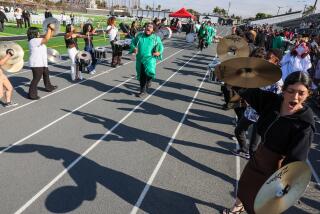Tapping Into the Process of Learning : Class Links Mastery of Musical Beat to Academic Skills
- Share via
With all eyes trained on their teacher, the group of second-graders at Ventura’s Mound School tried to follow her every move as they clapped their hands, slapped their thighs and kicked their heels to the tune of blue-grass music.
But some children were struggling: Their hands hit their left knees when they should have gone to the right. Their legs flew up into kicks at the moment that they should have hit the floor.
“It’s kind of hard to get the message down to your legs as fast as the music,” 7-year-old Kerianne Hewitt said.
Learning to get messages from the mind to the body as swiftly as possible is precisely the point of Mound’s motor-skills class.
The elementary school launched the class four years ago based on research showing that the ability to respond physically to a musical beat is closely linked to children’s skills in reading, writing and concentration.
And the class is working, Principal Beverly McCaslin said.
“We have noticed it helps kids concentrate and hold their attention span longer,” she said. “We have seen kids who have difficulty reading and writing improve because they are able to organize their thoughts better.”
Mound teacher Joanne Bowie leads the motor-skills instruction every Friday for each of the school’s first- through fifth-grade classes.
During some classes, the students clap, march or jump rope. In others, they recite poems to music. “I try to present it in a variety of ways just to keep the interest up,” Bowie said.
But the goal in all the class activities is to help children learn to keep a steady one-two beat with the music.
Bowie bases her instruction mainly on workshops she has taken from Phyllis S. Weikart, a retired physical education professor from the University of Michigan.
A nationally recognized expert in motor-skills development for children, Weikart maintains that children should begin to develop an innate sense of timing when they are infants.
When care-givers pat or stroke babies to the tune of a lullaby, for example, they are helping the children make a connection between what they hear and what they do, Weikart said in an interview from her Michigan home.
That “hearing-feeling connection,” as Weikart calls it, is what allows children to listen to something that is being said or watch something that is being done and follow the directions. “What you’re linking is action, thought and language,” she said.
And having a sense of inner timing allows children to speak or read in whole sentences instead of just one word at a time.
But studies show the number of children with the ability to keep a steady beat has declined in recent decades from a range of 80% to 90% to about 10%, Weikart said.
“I feel it’s probably the most fundamental of all the problems we face in education today,” she said.
*
She believes that the fault lies partly with adults who mistakenly believe that children respond better to the rhythm of words or syllables than to a steady beat. Many adults today, for example, clap the hand game “Patty Cake” with children to the rhythm of the words’ syllables rather than to a steady one-two beat, Weikart said.
“What’s happening today is that the children are receiving movement stimulation in rhythm rather than in beat,” she said.
At Mound, Bowie said she finds at the beginning of each year that only about one-third of the students can independently keep a steady beat. By the end of the year, the number climbs to two-third.
And the children said they have become more confident about their abilities to move to music.
“I was just really shy” at first, 8-year-old Jordan Frye said. “It’s just really neat to see that you can dance.”
More to Read
Sign up for Essential California
The most important California stories and recommendations in your inbox every morning.
You may occasionally receive promotional content from the Los Angeles Times.













